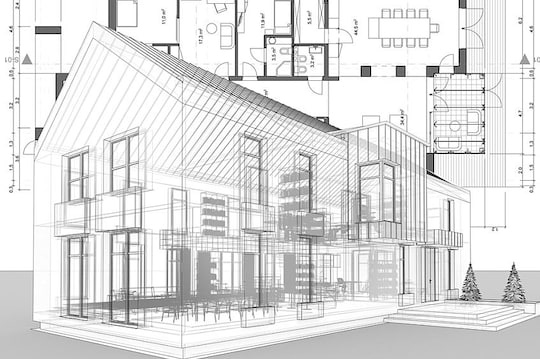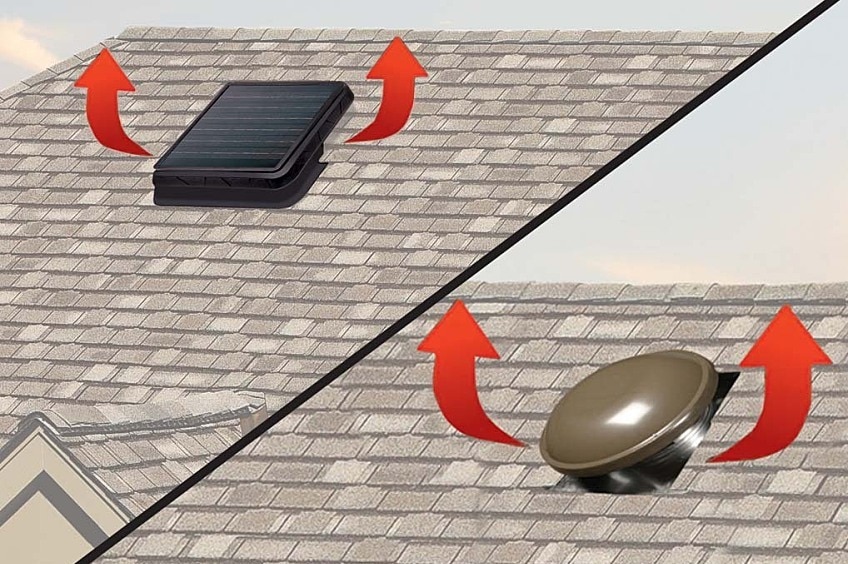
A balanced attic ventilation system helps reduce damaging heat and moisture in attic spaces, which may help reduce the load on air conditioning systems and lower the risk of ice dam formation in the winter.
Here are some of the most common attic ventilation systems and how to determine which option may be right for you.
Power Attic Ventilation Systems
Under the umbrella of powered attic ventilation systems, you have a few options to consider. Powered vents come in solar-powered and hardwired versions, and they can be roof mounted or gable mounted. In order to stay efficient, most systems use a thermostat to trigger power attic fan operation—but it's worth digging a little deeper into how these systems differ.
Hardwired Powered Vents
Hardwired powered vents are connected directly to the house's electrical system, providing a consistent source of power. Fans come in a range of power levels depending on the level of air movement needed. For example, the GAF Master Flow ERV6 Roof Mount Power Attic Vent provides 1,500 CFM for attics up to 2,800 square feet.
Solar-Powered Vent Fans
Solar-powered fans are easy to install. They rely on a small solar panel for power, making these vent fans a great option in areas with good exposure to the sun. Some solar-powered fans come with batteries or the option to connect to the building's electrical system as an alternative to solar. This helps to ensure that the fan has consistent access to power. GAF has a high-powered model in its Master Flow line as well as unique dual-powered models that switch automatically between solar and house power.
Roof Mounted Power Vents
Power vents can be mounted on the roof surface, generally close to the ridge or to the highest part of the attic. Most roof vent fans have a low profile, but customers may want to have them installed on the back of the roof for aesthetic purposes. The GAF Master Flow ERV4 Roof Mount Power Attic Vent provides enough airflow for attics up to 1,600 sq. ft.
Gable Mounted Powered Vents
Gable mounted vents are installed on the side wall of the attic. They come in both hardwired and solar options. Installed on the interior of the attic and with no exterior profile, the fans are easy to hide; the GAF Master Flow EGV5 Gable Mount Power Attic Vent is also an easy power vent to install.
Is It Best to Use Electric or Solar-Powered Attic Vents?
Electric hardwired attic vents are a good option when there is limited exposure to the sun and for higher-powered fans. Hardwiring provides a consistent power source that doesn't depend on natural conditions.
Solar-powered attic vents are a good option when exposure to the sun is not an issue and your project doesn't require a higher-powered fan. Overall, solar power vents often work best in climates which have less excessive heat. Regardless of what option you select, it's critical to ensure that the system is balanced.
How Much Does It Cost to Install a Power Vent?
Installation costs vary depending on the amount of work required and the number of fans needed. Some common costs include:
- Powered ventilator (cost may vary depending on the size and type)
- Penetrating the roof or side wall of house, if not already done (costs may vary)
- Installation labor (costs may vary)
- Wiring from vent location to the nearest electrical source (costs may vary)
- Making electrical connections (costs may vary)
- Exterior louver if gable mounted
Other Options for Attic Ventilation
Other popular options for attic ventilation include static and mechanical vents. Static vents are openings that allow hot air to escape as air flows through the attic: air comes in from the intake vents at the lower level of the roof and rises to the top, where it exits through vents on the ridge or roof high point.
Mechanical vents rely on wind power to turn a turbine, which draws hot air from the attic to the outside. These fans rely on a fairly constant wind of at least 5 miles per hour to keep the air moving.
If you'd like more information about power attic ventilation design and options, visit the GAF Learning Portal. For attic ventilation products that keep your most critical needs in mind, consider the GAF Master Flow product line.






